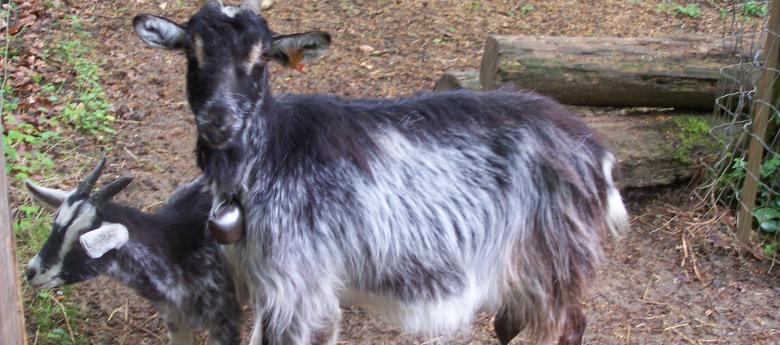In 2006, students from ENSAIA carried out a census and characterization project for animals that have been identified as the “Lorraine Goat”. Only 9 breeders and 78 animals have been identified in the territory. This low number has raised serious mobilization toward trying to save what could still be saved, in the name of natural heritage as well as cultural heritage. An association was created, the Association of the Friends of the Lorraine Goat, with the objective of protecting the Lorraine Goat breed and increasing their numbers.
The Lorraine Goat, called the goat for “the common people”, is characterized by:
- an ermine gray coat
- rather tall in height: an adult goat measures at least 68 cm at the withers, a buck 5 cm more. An adult goat weighs 50 to 60 kg, with a buck weighing between 70 and 90 kg.
- a semi-long coat
- average milk production: between 500 and 800 liters for an adult goat
- a rustic character that allows it to resist extensive breeding conditions
- strong walking and land-clearing capacities, even on rough terrain
Getting recognition of the Lorraine Goat as a distinctive breed required two different administrative formalities:
In October 2013, the “small ruminant” commission of the CNAG (the national commission of genetic improvement) gave its accord for the dossier submitted by the Association of the Lorraine Goats.
Then, in July 2013, the recognition was official with a decree issued by the Ministry of Agriculture, which stipulated that in the caprine breeds, there was now a “Lorraine” breed, a recognized breed, a local breed and a breed with small numbers.
In parallel, the enthusiasm for the association presided over by Stefan Jurjanz, teacher-researcher at ENSAIA-URAFPA, has been surprising and the numbers (both caprine and human) have increased quite rapidly.
Each year, incidentally, 1 to 2 breeders have been added to the number that breed the Lorraine Goat.
Today, the association includes professional and amateur breeders (in the Lorraine, as well as Alsace, Ardennes, Haute Marne, Haute Saône and the Belgian Lorraine), those who are simply passionate about the breed and other establishments such as the Parc Animalier de Sainte Croix, the animal reserve in the “Parc de la Pépinière” in Nancy, the farm at the Centre Parc in Hattigny, l’ENSAIA , the association F.E.R.M.E and even at the Fort in Villey-le Sec.
The genealogical file, the “goat book”, drawn up by the association, listed more than 700 living caprines at the end of 2013, which is 8 times more than there were in 2007.

